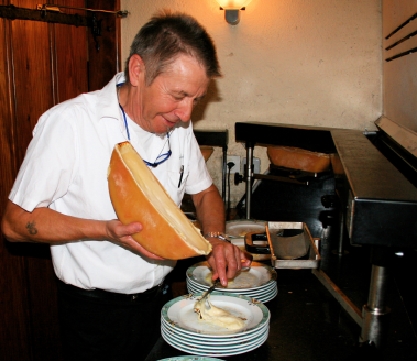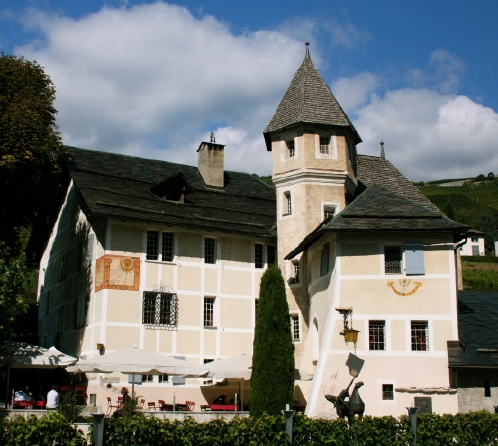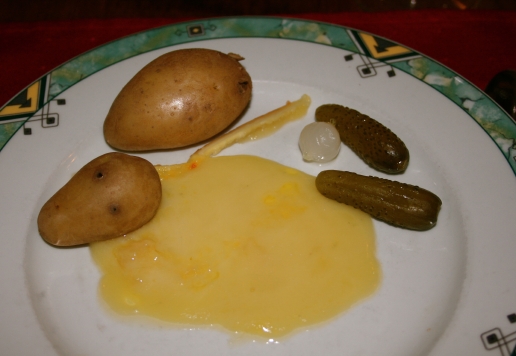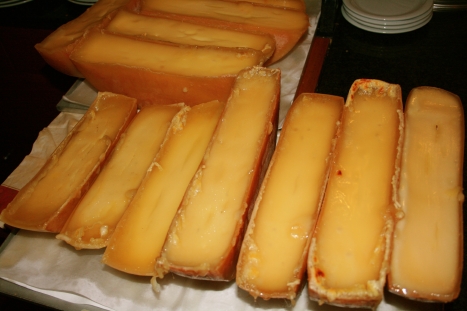The “national” dish of the Swiss canton of Valais is raclette (AKA: pools of melted alp cheese), and the best place to eat it is the Château de Villa in the winemaking town of Sierre (not far from the cantonal capital of Sion).

Raclette is a traditional Swiss melted-cheese dish. Here, Alex Aldel scrapes the bubbly raclette onto a plate at the Château de Villa. Behind him, you can see another half-cheese heating under the raclette-oven burner. ©Laurel Kallenbach
By the way, in Switzerland I heard the dish pronounced with the emphasis on the first syllable: RAH-clet. And the name is from the French word, racler: “to scrape.” (Keep reading! You’ll see why soon.)
The Château de Villa is a restored 16th-century castle, so you’re dining in ancient ambiance. The Château’s restaurant was established in the early 1950s to promote local, traditional foods: specifically Valaisian wine, air-dried beef and raclette made using raw milk from alpine meadows.

The 16th-century Château de Villa in Sierre serves raclette; it also specializes in Valais wine, which it sells in its extensive wine cellar. ©Laurel Kallenbach
The Château’s literature proclaims itself as “Le Temple de la Raclette,” and it’s earned the designation: Both Swiss gourmands and visitors (like me!) flock here to worship its gooey cheese. In fact, the Château de Villa is so popular that you should book a reservation a month in advance. They serve 15 tons of cheese a year!
How the Cheese Bubbles
Château de Villa offers a special tasting of five mountain-alp cheeses for 31 CHF (Swiss francs) per person. You can see on a map the tiny villages where each cheese is made.
Tonight, Alex Aldel is our racleur (the scraper of the raclette), and he can keep multiple plates going at once. He’s like a master of ceremonies; he keeps the cheese rolling. I have privately dubbed him The Cheese Meister.

The melted raclette on my plate with boiled potatoes, cornichons, pickled onion, and a small bit of the cheese’s crust. This heat-crisp crust is called “la religieuse” (the nun). ©Laurel Kallenbach
Here’s how the raclette process happens:
1. The racleur selects a half-cheese (Cheese #1) and places it under the raclette-oven burner. He also sets out a row of plates to warm.
2. He checks the cheese from time to time, watching until the surface starts to bubble. Meanwhile, he’s usually watching other varieties of cheese in process.
3. When the cheese is bubbling, the racleur uses a small knife and deftly scrapes a portion onto a plate, usually with one swoop.
4. The racleur whisks the warm plates to the table, and we diners scramble to add boiled potatoes, cornichons (teensy pickles), sourdough rye bread (another Valais specialty), and pickled onions to eat with our cheese while it’s still hot.
5. When you’ve finished your plate, the whole process starts over with Cheese #2.

Half-wheels of raclette cheese from all over the Valais region await melting. Each tastes slightly different. ©Laurel Kallenbach
Tonight, I sample nutty, buttery, toasty raclette cheeses from the Bagnes Valley, Les Haudères in the Hérens Valley, Les Marais in the Anniviers Valley, Turtmann, and the Goms Valley.
They’re all delicious. Some are mild, some more strong. I can detect differences in flavor, but honestly my palette isn’t as tuned to the distinctions as a local would be.
Martin Hannart with Sierre-Anniviers Tourism says: “We people of Valais learn how to make raclette before we learn to walk!”
And that, in a nutshell, sums up how the Swiss feel about their cheese.
—Laurel Kallenbach, freelance writer and editor
Originally posted in October 2010
Read more about my travels in Switzerland:
- Swiss Wine Country: Picturesque & Superb
- Hiking the Valais Wine Trail
- Sleep in the Straw in Switzerland
- Switzerland’s Imperial Crown Mountains
- Adopt a Swiss Cow and Support Sustainable Dairies
- Swiss Farmer Grows Organic Herbs for Ricola
- Swiss Farms: The Source of the Cheese
- Cows on Parade: A Swiss Celebration


Thank you Laurel–Switzerland never seemed as enticing as Tuscany when it came to food, but this is changing my mind. Love the hiking too.
You know, I was pleasantly surprised by the fine food in Switzerland. I had fresh crisp salads, incredible wine, and beautifully prepared meats. And, right now a favorable exchange rate makes the Swiss franc pretty close to equal the American dollar. So, prices don’t seem so shocking as they have on past trips. Great time to visit!
How incredibly inviting–from the descriptions, passion, and photos–drooling
Yes! I had to sip wine while blogging–it was just too hard to write about wonderful wine and food without enjoying some. Of course, the wine I imbibed on here was Spanish–the Swiss don’t really export wine outside of Europe.
We’ve had raclette at the home of friends, so appreciate this wonderful explanation (and the photos!) of the process. Thanks for a vicarious international culinary treat!
It seems shocking that I ate five samplings of the cheese, each about the size of the portion on the plate in the photo. But, when you’re sipping wine and talking about pretty cows with ringing cowbells in the alpine meadows you just feel inspired to eat up!
Cheese, castles AND wine? Sounds like you found the perfect destination!
Raclette is my MOST favorite cheese… it even freezes well. jean